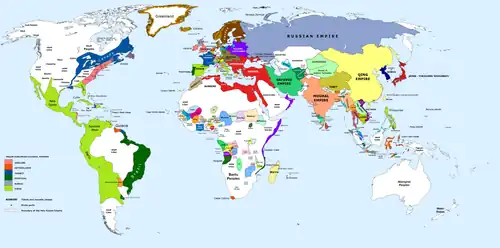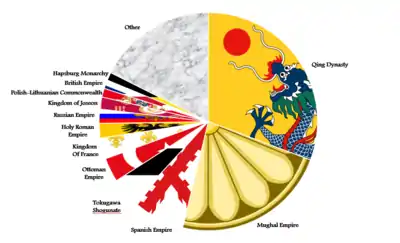Liste des pays par population en 1700
Ceci est une liste de pays par population en 1700. Les chiffres estimés datent du début de l'année 1700 et les chiffres exacts concernent les pays ayant organisé un recensement à différentes dates au cours de l'année 1700. La majeure partie de ces chiffres provient de l'ouvrage Two Thousand Years of Economic Statistics d'Alexander V. Avakov, volume 1, pages 18 à 20, qui couvre les chiffres de la population de l'année 1700 en fonction des frontières modernes. V. Avakov lui-même cite diverses sources, dont principalement Angus Maddison.

Le monde en 1700.

Références
- « The World at Six Billion » [archive du ], UN Population Division, Table 2
- József Böröcz, The European Union and Global Social Change, (ISBN 9781135255800, lire en ligne)
- William T. Rowe, China's Last Empire: The Great Qing, , 91 p.
- The combined population of Germany (15m), Austria (2.5m), Czechia (3.242m), Belgium (2m), Slovenia (0.248m), and a third of Italy (4.4m), Avakov, p. 18-20.
- J.P. Sommerville, « The Holy Roman Empire in the Seventeenth Century » (consulté le ). Archived here. The figure of 20 million is given for "Germany, Austria, and Bohemia", a definition of the Empire that specifically excludes the Empire's Italian territories such as the Savoyard state, Milan, and Tuscany, as well as its territories in the Low Countries.
- Avakov, p. 18.
- And related territories roughly covering the modern borders of Austria. Avakov, p. 18.
- Dwyer, Philip G. The Rise of Prussia 1700–1830. United Kingdom: Taylor & Francis, 2014. Page 52. The population of all of the King in Prussia's domains is given as 1.5 million in 1713, and the bulk of these lived within the Empire, rather than in the smaller and more barren holding in Ducal Prussia.
- Wilson, Peter H. War, State and Society in Württemberg, 1677–1793. 1995. Page 43.
- Peter Wilson. "German Armies: War and German Society, 1648–1806." 2002. Page 21. Combined population of Luneberg and Brunswick-Wolfenbuttel.
- Jean-Noël Biraben, "The History of the Human Population From the First Beginnings to the Present" in "Demography: Analysis and Synthesis: A Treatise in Population" (Eds: Graziella Caselli, Jacques Vallin, Guillaume J. Wunsch) Vol 3, Chapter 66, pp 5–18, Academic Press, San Diego. (2005)
- Alexander V. Avakov, Two Thousand Years of Economic Statistics, Volume 1, (ISBN 9781628941012, lire en ligne)
- Maddison, « Growth of World Population GDP and GDP Per Capita before 1820 » (consulté le )
- Bogdan Murgescu, Romania si Europa, Polirom, , 75–76 p. (ISBN 9789734620418, lire en ligne)
- « Population Statistics: Historical Demography » [archive du ] (consulté le )
- « A History of Spain and Portugal » (consulté le )
- « European Population History » (consulté le )
- Roughly the modern borders of Slovenia. Avakov, p. 20.
- Mitchison, A History of Scotland, pp. 291–2 and 301-2.
- MArshall, John, « Statistics of the British Empire »,
- Grada, C. O., « The Population of Ireland: 1700–1900, A Survey »
- « ESTIMATED POPULATION OF AMERICAN COLONIES: 1610 TO 1780 »
- « Population of the English West Indies, 1655–1755 »
- Li 1998, p. 160-171.
- Dwyer, p. 52.
- Geoffrey Symcox. "Victor Amadaeus II: Absolutism in the Savoyard State, 1675–1730." Page 245.
- Clarke, « In the Eye of Power: China and Xinjiang from the Qing Conquest to the "New Great Game" for Central Asia, 1759 – 2004 » [archive du ], (consulté le ), p. 37
- (en) Thornton, « Revising the Population History of the Kingdom of Kongo », The Journal of African History, vol. 62, no 2, , p. 201–212 (ISSN 0021-8537, DOI 10.1017/S0021853721000451, lire en ligne)
- (a) Yoshio Oguchi, "Demographics of Satsuma Domian", Reimeikan Chōsa Kenkyū Hōkoku (no. 11), pp. 87–134 (1998). (b) Yoshio Oguchi, "Demographics of Satsuma Domian and early modern Ryūkyū", Reimeikan Chōsa Kenkyū Hōkoku (no. 13), pp. 1–42 (2000) (all in Japanese).
- Tana Li, Nguyen Cochinchina: Southern Vietnam in the Seventeenth and Eighteenth Centuries, Cornell University Press, (ISBN 9781501732577)
- Kurt Witthauer. Bevölkerung der Erde (1958)
- Calendario atlante de Agostini, anno 99 (2003)
- The Columbia gazetteer of the world (1998)
- Britannica book of the year : world data (1997)
Articles connexes
Cet article est issu de wikipedia. Text licence: CC BY-SA 4.0, Des conditions supplémentaires peuvent s’appliquer aux fichiers multimédias.